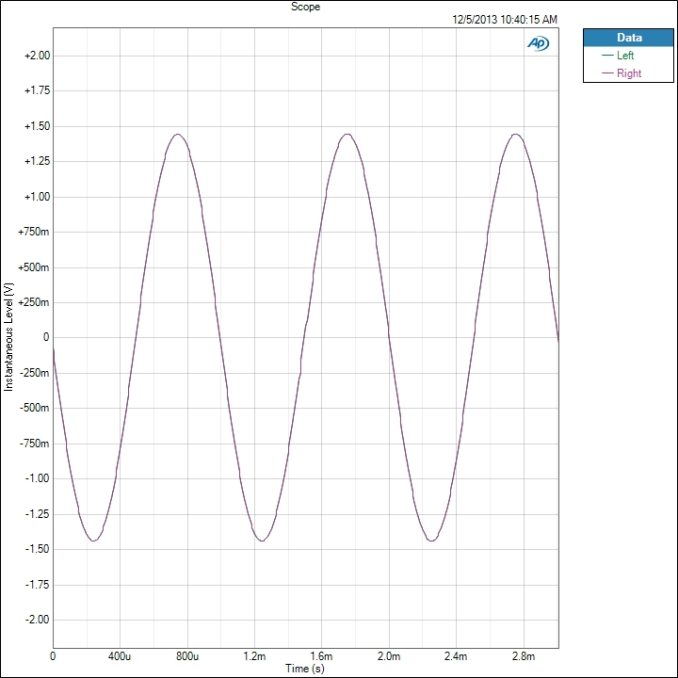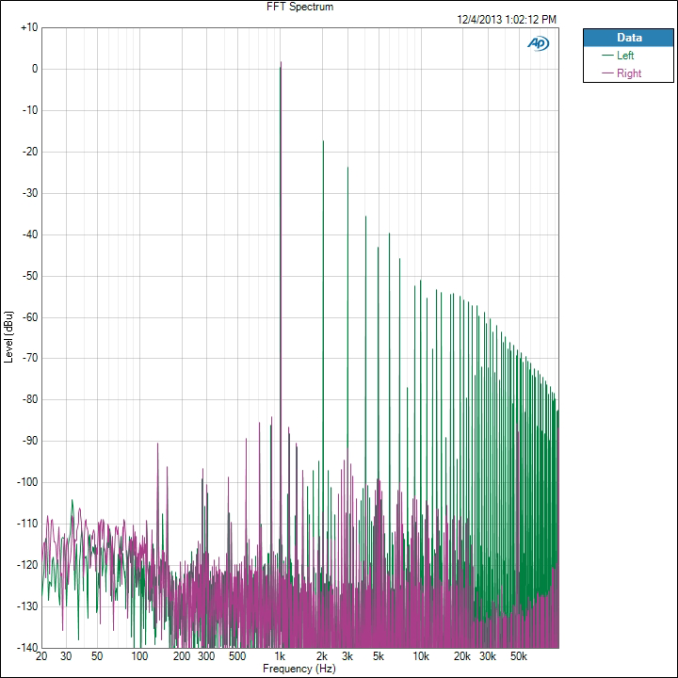Smartphone Audio Quality Testing
by Chris Heinonen on December 8, 2013 5:15 PM EST- Posted in
- Smartphones
- Audio
- Mobile
- Tablets
- Testing
THD+N is a measure of the total harmonic distortion and noise compared to the signal. The lower the number, the less distortion and noise there is relative to the fundamental frequency. THD+N is measured by driving a 1 kHz sine wave at maximum volume. Because there is always some inherent background noise, the THD+N is almost always lowest at maximum output so that is used for the measurement.
There are two results that we take from this: a sine wave and a FFT spectrum. On the sine wave both channels should line up perfectly, and it should be as close to an accurate sine wave as possible. On the FFT we want to see a peak at 1 kHz and everything else as low as possible. The most common artifact you will see are harmonic sidebands at multiples of 1 kHz.
For an example of data that looks good, here is the sine wave of the iPhone 5. We see a sine wave that is good, with channels that overlap perfectly and no deviation. This is what we expect to see.
Now for a different example we look at the Nexus 5. Run at maximum volume we see that the left channel is clipping in the sine wave. Likely the power to the headphone amplifier is not enough to drive both channels and so this is the result. UPDATE: Tested this with 4.4.1 and no change.
The iPhone 5 produces a THD+N ratio of 0.003134% while because of the clipping, the Nexus 5 is producing 13.789197%. Any level over 1% is considered to be past the clipping point of an amplifier and it seems that the Nexus 5 cannot be driven at maximum volume. I tested two samples to verify, and on both the performance is identical.
Now if we look at the FFT for this test, we see how this distortion is showing up. First, the iPhone 5 is very quiet.
There is a 2 kHz peak that is -93 dB below the fundamental frequency, and the 3rd harmonic at 3 kHz is over -109 dB below it. All the harmonics past that are at -120 dB below the fundamental tone. There is some noise out at 50 kHz but this is so far past the level of human hearing that it is safely ignored. Now the Nexus 5 FFT.
We see the right channel, which didn’t clip, looks good. The 2nd harmonic is -111 dB and the 3rd harmonic is -93 dB. On the left channel the 2nd harmonic is only -18 dB and the 3rd harmonic is -24 dB. Even at the 9th harmonic we are still only -52 dB below the fundamental tone. This is causing these incredibly high THD+N numbers that we are seeing on the Nexus 5. We will see more detail of this on a later test as well.
We also chart THD+N vs. Frequency. Here is the chart for the Note 3.
We see that THD+N is basically right below 0.08% for the whole spectrum. It moves up and down slightly, but is very constant. Now here is that Nexus 5 data.
We see that the right channel is around 0.01% THD+N while the left channel, the clipped one, is over 3%. If we ran the Nexus 5 at a lower volume level we would see totally different results, as you’ll find out later, but this is how devices are typically measured.
















188 Comments
View All Comments
UsernameAlreadyExists - Friday, December 13, 2013 - link
That would be great. I believe most display tests are run with the same light output to have more reasonable comparisons... I would like to see the same principle here. As a curiosity (or a warning) it would be good to know that above certain levels the sound will deteriorate.bob11d50 - Sunday, December 8, 2013 - link
I would love to see the distortion of the apple on a standard headphone (16 ohms). They have notoriously bad sound quality all they way back to the first ipod. Apple is a profit company not a quality company.I would also like to see a real comparison of battery life on apple products. Like battery life VS screen size in SQ inches. The screen is so small who cares if it can brows the web for 10 hours if you cant see it.
Also frame rate VS pixel count. Once again I can refresh a 1 pixel screen at 1Mhz but it does not do me any good nor does a 1M Pixel screen at 1 Hz but the spec is the same 1M pixels a second.
Robert
NeoteriX - Monday, December 9, 2013 - link
I am not an Apple evangelist having only owned Android (and WM and Palm) smartphone devices. So with that said, this is a truly ignorant statement. Apple has led the way on several different design and hardware fronts, including display quality and size, camera quality, GPU power, etc., and it's not clear that without their leadership there would be the kind of robust hardware competition there is in the PC and Android space.deasys - Monday, December 9, 2013 - link
"They have notoriously bad sound quality all they way back to the first iPod"Sure, Bob, whatever you say. Of course, there are authoritative sources that disagree with you. For example: http://www.stereophile.com/content/apple-ipod-port... which summarizes by stating, "Excellent, cost-effective audio engineering from an unexpected source."
I think I'll take Stereophile's word over yours, Bob…
akdj - Monday, December 9, 2013 - link
deasys hit the nail on the head Bob---Not sure which iPod/iOS device YOU'VE hear/listened to/had experience with....but as an absolute audio nerd, I can assure you decent audio files sound excellent....my favorite cans right now are the B&W P5s currently, but I've also got 2 pairs of Grados, Sony MDR 7520s, and Sennheiser HD800s for our studio mixing (with B&W Nautilus 802 speakers and Focal SM9 studio monitors). You couldn't be more dead wrong about Apple's sound quality. Perhaps you need to find a new way to 'rip' your music or quit listening to low bitrate MP3s to judge sound quality?As far as screen/battery life----WTF does that have to do with this incredibly extensive, exhaustive sound quality review and comparison/contrast between three Android phones and an iPhone?
Bone to pick, eh?
LoL----Doesn't matter does it....regardless of the article, review, discussion----always SOMETHING to do with Apple isn't it?
winchuff - Wednesday, December 18, 2013 - link
The devil is always in the detail... Unfortunately deasy, the detail you failed to pick up on is that the 'stereophile' tests were performed into the mackintosh powerbook 'line in' impedance and so did not uncover the limitations of the analogue output stage when listening via headphones.winchuff - Wednesday, December 18, 2013 - link
You're dead right Bob (whatever the other numpties say). The problem with the ipods (except for the first gen iPod nano, which was superb) is down to an underpowered analogue output stage. There is no problem when driving a high impedance 'line out', but it results in clipping and poor bass response when driving (low impedance) headphones. For those of us listening via headphones, the most crucial objective test is performed when driving into a low impedance. If anandtech do the low impedance tests, you will be vindicated for identifying the shortcomings of the apple devices. And the numpties who know no better will eat humble pie.FYoung - Sunday, December 8, 2013 - link
I commend you for taking this initiative. I agree that audio testing by sites like Anandtech could eventually lead to phones with better sound quality, which is something that has been neglected so far.However, I wish you tested the audio quality of phone calls as well. Cell phones are phones, after all. It doesn't look to me that these tests measure the ability of a phone to selectively capture the spoken voice in a loud environment (without omitting the first syllable of a sentence) and reproduce the voice reasonably accurately and reasonably loudly through its speaker, which is what a cell phone must do to function as a phone in real life.
If no objective and reproducible test currently exists to do this, why not invent one?
As for me, I have an S3, and I find the speaker volume barely sufficient to hear the caller's voice. I consider this a significant and entirely unnecessary weakness of the S3. A phone's ability to carry a conversation is far more important than its competence as a camera or music player.
Impulses - Monday, December 9, 2013 - link
Those might be your priorities, not necessarily everyone else's though. I can tell you I'd be much more concerned how a phone would fare with music than with calls... I use maybe 200-300 voice minutes a month but I probably spend at least twice as long listening to music/podcasts on my phone (if not thrice as long).In the same vein, I couldn't care less about the camera as long as it's usable enough for basic stuff like snapping a pic of something as a reminder while I'm at a store... I still use my pocket camera or my micro four thirds camera for any picture of any moment I'd truly like to remember.
However I KNOW that's not a majority view and for many many people a smartphone is now their primary camera, so I can appreciate the efforts Brian puts towards evaluating those. I'd imagine that anyone who speaks a ton on their smartphone probably uses a Bluetooth device and I'd bet that's ultimately a bigger factor in call quality (along with the network).
Not saying it wouldn't be interesting to test mind you, just adding some perspective.
DarkXale - Monday, December 9, 2013 - link
Aside from lacking more precise test methodology, and having way too many variables compared to reality to make the tests reliable in reality - such evaluations are already fairly regularly performed during reviews of the device.Do keep in mind most carriers will not support frequencies outside the 300-3400mHz range; inadequate for a decent voice conversation.
If you are concerned about voice quality, your first priority should be to get the carriers to support wideband audio. Without it, the phone manufacturers themselves can't do that much.
Apple only introduced it with the iPhone 5, but others like Nokia have supported it in their phones far longer, even prior to the release of Windows Phone (7), including support in virtually every device they've released. (Whether its a low end Asha, Lumia 500/520, or a high end 900/920).
Even the popular Galaxy 2, 3, and 4 support it - so there is no shortage of devices with the capability.